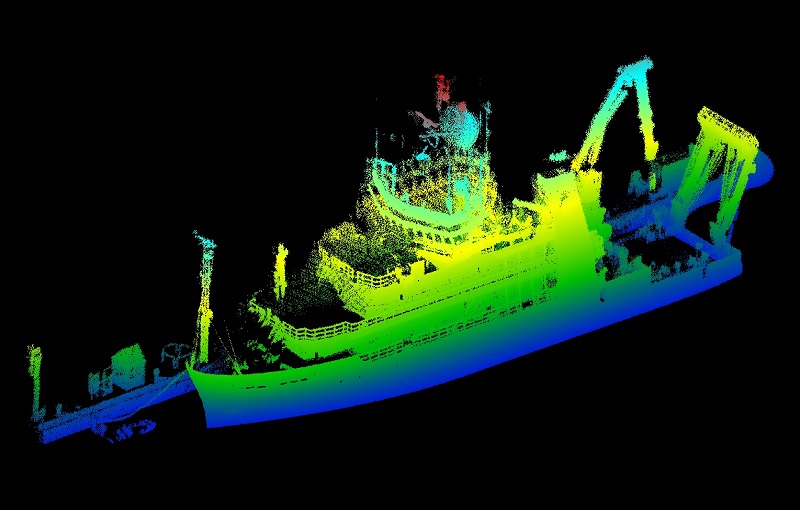Introduction
The data generated by LiDAR systems on smart ships is critical for safe navigation, operational efficiency, and decision-making. However, managing and securing this data poses significant challenges, particularly in the context of cyber threats and the need for reliable data storage and transmission. This article will explore the best practices for data management and security protocols for LiDAR systems on smart ships, covering topics such as data encryption, redundancy, secure transmission methods, and preventing unauthorized access.

Importance of Data Encryption
Data encryption is one of the most critical security measures for protecting LiDAR data on smart ships. Encryption ensures that even if the data is intercepted or accessed by unauthorized parties, it cannot be read or used without the appropriate decryption keys. Given the sensitive nature of navigational data, which could be exploited by malicious actors, encryption is essential for safeguarding the ship’s operations.
LiDAR data should be encrypted both at rest and in transit. This means that data stored on the ship’s servers or backup systems should be encrypted, as well as any data transmitted to shore-based facilities or other vessels. Advanced encryption standards (AES) are typically recommended for this purpose, offering a high level of security without significantly impacting system performance.
Implementing Data Redundancy
Redundancy is a critical aspect of data management on smart ships, ensuring that LiDAR data is not lost in the event of a system failure. This can be achieved by implementing multiple layers of data storage, including onboard servers, external hard drives, and cloud-based storage solutions. By maintaining copies of the data in multiple locations, the risk of data loss due to hardware failure, accidental deletion, or cyberattacks is significantly reduced.
In addition to physical redundancy, logical redundancy should also be considered. This involves creating multiple copies of the data in different formats or locations, ensuring that even if one copy is corrupted, others remain accessible. Regular backups are essential to maintaining data redundancy, and these backups should be performed automatically and verified periodically to ensure their integrity.
Secure Transmission Methods
The transmission of LiDAR data from smart ships to shore-based facilities or other vessels is another critical aspect of data security. Given the potential for cyberattacks targeting data transmission channels, secure transmission methods are essential. This can include the use of Virtual Private Networks (VPNs), Secure Sockets Layer (SSL) certificates, or other encryption protocols to protect the data as it travels across networks.
Additionally, data transmission should be monitored for any signs of unauthorized access or tampering. Intrusion detection systems (IDS) can be deployed to alert the crew to potential security breaches, allowing them to take immediate action to secure the data. In some cases, it may also be necessary to limit the transmission of sensitive data to specific, trusted networks, further reducing the risk of interception.
Preventing Unauthorized Access
Preventing unauthorized access to LiDAR data is a critical component of data security on smart ships. This involves implementing strict access controls, ensuring that only authorized personnel can view, modify, or transmit LiDAR data. Access controls can be enforced through the use of passwords, biometric authentication, or keycards, depending on the ship’s specific security requirements.
In addition to controlling access to the data itself, it is also important to secure the systems that process and store the data. This includes implementing firewalls, antivirus software, and other security measures to protect against malware, viruses, and other cyber threats. Regular security audits should be conducted to identify and address any vulnerabilities in the ship’s data management systems.
Data Integrity and Authenticity
Ensuring the integrity and authenticity of LiDAR data is essential for maintaining trust in the system’s outputs. This involves implementing measures to prevent data tampering, whether accidental or malicious. Digital signatures and hash functions can be used to verify the authenticity of data, ensuring that it has not been altered since it was collected.
In addition to protecting against tampering, it is also important to maintain the accuracy and completeness of the LiDAR data. This can be achieved through regular calibration and testing of the LiDAR system, as well as through the use of error-checking algorithms that identify and correct any anomalies in the data.
Conclusion
Data management and security are critical aspects of operating LiDAR systems on smart ships. By implementing best practices such as data encryption, redundancy, secure transmission methods, access controls, and measures to ensure data integrity and authenticity, ship operators can protect the sensitive information generated by their LiDAR systems. These precautions are essential for maintaining the safety, efficiency, and reliability of maritime operations in an increasingly digital world.


